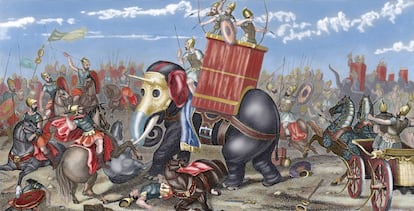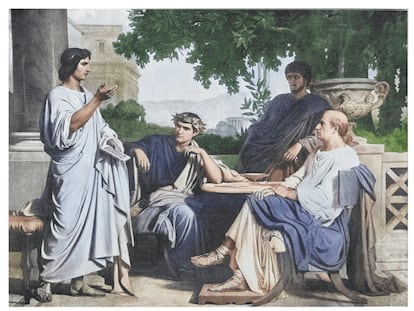War elephants: How Carthage used a ‘psychological’ weapon the Romans failed to master
Both Hannibal and Julius Caesar used pachyderms in their campaigns in Hispania, but the Carthaginian general had far more expertise in their deployment than the legions


Mythology, literature, painting, art, scientific studies… Everything is intermingled in the story of the Carthaginian general Hannibal Barca (247-183 B.C.) and his legendary passage through the Alps with 37 African elements to launch his attack on Rome. The recent discovery in Córdoba of a carpal (hand bone) — possibly from one of Hannibal’s specimens or from one of the pachyderms that also accompanied Julius Caesar on his campaigns in Hispania — has placed new focus on a scientific history that does not always coincide with the historiographic one. However, all the elephants that the Carthaginian strategist used died of exhaustion, starvation, or in the various battles he fought to gain control of the western Mediterranean. There is less data available for the animals deployed by Caesar in the Iberian Peninsula because, as professor of Archaeology at the Autonomous University of Madrid, Fernando Quesada, affirms, the Roman general led “confused military campaigns” that are still being unraveled at the archeological site of Montemayor in Córdoba. But elephants were used by the Romans, although sporadically and on many occasions poorly with deadly results for their own side. The fear the legionaries held that the beasts could turn against them was so great that Caesar, before the battle of Thapsus in Tunisia (46 B.C.), brought specimens that were slated for the gladiatorial arena for his men to become accustomed to, and to hone their readiness to fight enemy pachyderms.
The first battle where elephants were deployed as a combat weapon was Gaugamela (330 B.C.), in present-day Iraq, where Alexander the Great met the forces of the Persian King Darius III, who arrived on the field with very few specimens and was defeated. A few years later, in India, Alexander faced King Porus, who used 200 pachyderms. But these proved to be of little use against the masterful Greek tactician. In the western Mediterranean basin, the Greek King Pyrrhus of Epirus used elephants in his fight against the Romans in Sicily between 280 and 275 B.C. The impact of pachyderms on the battlefield must have been staggering. “The elephant, seen for the first time, must have been viewed with fear and amazement. The bellowing, the use of the trunk, and the obvious size caused terror in enemies,” explains historian Christian San José in a paper entitled Hannibal’s Elephants.
The Carthaginians copied the military use of elephants from the Egyptians, who deployed smaller Asian elephants. Carthage, on the other hand, preferred North African elephants, which were hunted so intensely that they became extinct in less than two centuries. During the First Punic War (264-241 B.C.), the Spartan mercenary general Xanthippus had around 100 perfectly trained war elephants at his disposal for the Sicily campaign against Rome.
The Romans, for their part, used pachyderms for the first time in the Second Macedonian War (200-197 B.C). These animals were supplied by the Numidian kingdom to the consul Publius Sulpicius Galba Maximus. In Hispania, 10 proboscideans were deployed during the 153 B.C. siege of Numantia. The consul Quintus Fulvius Nobilior launched them against the Celtiberian Arevaci, but the animals became so panicked that the attack ended in disaster for the Romans. According to the historian Appian, Quintus Fulvius Nobilior chased the Arevaci to the walls, “where they fought bravely, until one of the elephants, wounded in the head with a large stone, became so enraged that, returning to his own with terrible bellows, he began to trample everyone he met, without distinction of friend or foe. At the bellowing of this one, the other elephants, enraged, began to do the same, and tramped, killed, and overpowered the Romans.”

Elephants as a “psychological weapon”
Historian Fernando Quesada explains in his study From warriors into soldiers: Hannibal’s force as an atypical Carthaginian army: “Since ancient times, the Carthaginians had used exotic weapons of ancient oriental tradition, such as the chariot, although it seems that already by the time of the Agathocles war (317-287 B.C.) its use had been extinguished. From the First Punic War, the elephant replaced the chariot as a psychological and exotic weapon, now within the Hellenistic tradition.”
King Pyrrhus favored Asian elephants (Elephas indicus), animals that have a huge body that allows them to carry a tower on its back with space for two archers. Hannibal, on the other hand, preferred the North African elephant, which was much smaller than the African elephant and the Asian elephant, standing between 2.4 and 2.5 meters high. Their size only allowed for a single rider, so they lacked a tower attached to their back, contrary to general belief.
Hannibal, according to the written sources of the time, used elephants in Hispania; first in 220 B.C. against the Vaccaei of Helmantike (modern-day Salamanca) and in the crucial battle of the Tagus where he faced the Olcades and Carpetani. At that time, he had 40 animals at his disposal. The Carthaginians sped up the training of elephants during the Hispanic wars, with Hannibal’s deployment rising to 58, 21 of which he gave to his brother Asdrubal to continue the fight against the Romans in Hispania, while he left for the conquest of Rome itself with 37 specimens.
The first difficulty Hannibal encountered was that the animals had to cross the wide Rhône. Historians offer two versions of how he was able to accomplish this. The first, based on the Greek historian Polybius, holds that the general built rafts over two hundred feet long and fifty feet wide to simulate dry land. The second suggests the animals were forced to swim the river, goaded with severe physical punishment. San José notes that pachyderms have the capacity to overcome a flow of 110 cubic meters per second. “The Rhône,” says the expert, “would therefore not pose any difficulty as it has an average flow of 60 cubic meters per second.”
Later, Hannibal famously crossed the Alps during a harsh winter, ascending snowy slopes under the threat of deadly avalanches, along slippery and waterlogged passes that had to be cleared to allow horses and elephants to pass. The Carthaginian’s pachyderms, according to recent studies, “demonstrate that these animals have perfect balance, a very stable footing and a great capacity to advance through steep and icy areas that, in some cases, even surpasses that of goats.”
Hannibal’s journey was a masterclass in logistics. An elephant can eat around 220 kilos of fodder a day, which multiplied by 37 meant a daily consumption of some 8,140 kilos. “In other words, the Punic general developed with precision and thoroughness a food storage and distribution system where elephants played a primary role. In short, Hannibal’s feat as a general must be understood from logistical parameters and not in the mere fact of getting the pachyderms through the mountains. His success in logistics and planning is evident in getting the elephants onto Italian soil,” writes San José.
The Battle of the Trebia was fought in December, 218 B.C. Hannibal placed his elephants in the front line, divided into two blocks, and threw them against the Roman cavalry. The Carthaginians won, but when he reached the Apennines, Hannibal had only one pachyderm left. Possibly all had died of starvation, since the general had not had time to create a logistical apparatus to feed them, as he did in the Alps. The Carthaginian Senate approved sending him 40 more, but these never materialized.
The end was near. Hannibal was Carthage’s final trump card. At the crucial battle of Zama (202 B.C.), in North Africa, he had 80 elephants at his disposal, which he placed in the front line of combat. But he made a serious mistake: he used completely inexperienced adult animals, which had been hastily captured in the forests of North Africa. The heat of battle turned the pachyderms against the Carthaginian ranks. “Generally, the elephants employed by the Carthaginians were young and easier to train than adults. But the haste of events caused these considerations to be overlooked. These factors decisively conditioned Hannibal’s tactical-military disposition. Therefore, the elephants of Zama, due to their advanced age, their inexperience in battle, and lack of preparation in military maneuvers” led to his defeat.
For his part, Caesar used elephants in his campaign in Hispania in 48 B.C. against the Pompeian faction. They were provided by the Mauritanian king Boguda. However, as historian Mario Llop notes in The Roman legions and war elephants: From discovery to use, this huge combat weapon came with the problems of “expensive food, breeding in a climate different from their own, gestation periods of twenty-two months to conceive a single calf, training instead of domestication, scarcity and difficulty in obtaining drivers and trainers, problems in hunting and transport, and extinction of African elephants north of the Atlas.” Llop says that, eventually, elephants were relegated “to circus arenas and mass spectacles because they lacked tactical value for the legions.”
Sign up for our weekly newsletter to get more English-language news coverage from EL PAÍS USA Edition









































